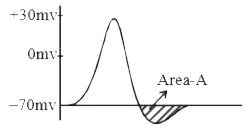How does nerve impulse travel in axon ?
Step-by-Step Solution:
1. Structure of the Neuron:
- A neuron consists of a cell body, dendrites, and an axon. The cell body contains the nucleus, while the axon is a long, elongated structure that transmits nerve impulses.
2. Myelin Sheath:
- The axon is covered by a myelin sheath, which acts as an insulating layer. This sheath is important for speeding up the transmission of nerve impulses.
3. Schwann Cells:
- Along the axon, there are Schwann cells that form the myelin sheath. These cells are crucial for the maintenance and function of the axon.
4. Dendrite Reception:
- The process begins when the dendrites of the neuron receive a nerve signal from a previous neuron’s axon terminal. This signal is in the form of an electrical impulse.
5. Propagation of the Impulse:
- The nerve impulse travels along the axon towards the axon terminal. This movement is facilitated by the rapid depolarization and repolarization of the axon membrane, which occurs due to the opening and closing of ion channels.
6. Axon Terminal:
- At the axon terminal, the nerve impulse triggers the release of neurotransmitters. This is where the electrical signal is converted into a chemical signal.
7. Release of Acetylcholine:
- The neurotransmitter released is often acetylcholine. This chemical is secreted into the synapse, which is the gap between the axon terminal of one neuron and the dendrite of another neuron.
8. Transmission to Next Neuron:
- Acetylcholine acts as a chemical messenger, transferring the nerve impulse across the synapse to the dendrite of the next neuron. The receiving neuron then processes this signal and continues the transmission of the nerve impulse.
9. Cycle Continuation:
- This cycle continues as the new neuron receives the signal and transmits it further along its axon, perpetuating the nerve impulse transmission.
- A neuron consists of a cell body, dendrites, and an axon. The cell body contains the nucleus, while the axon is a long, elongated structure that transmits nerve impulses.
- The axon is covered by a myelin sheath, which acts as an insulating layer. This sheath is important for speeding up the transmission of nerve impulses.
- Along the axon, there are Schwann cells that form the myelin sheath. These cells are crucial for the maintenance and function of the axon.
- The process begins when the dendrites of the neuron receive a nerve signal from a previous neuron’s axon terminal. This signal is in the form of an electrical impulse.
- The nerve impulse travels along the axon towards the axon terminal. This movement is facilitated by the rapid depolarization and repolarization of the axon membrane, which occurs due to the opening and closing of ion channels.
- At the axon terminal, the nerve impulse triggers the release of neurotransmitters. This is where the electrical signal is converted into a chemical signal.
- The neurotransmitter released is often acetylcholine. This chemical is secreted into the synapse, which is the gap between the axon terminal of one neuron and the dendrite of another neuron.
- Acetylcholine acts as a chemical messenger, transferring the nerve impulse across the synapse to the dendrite of the next neuron. The receiving neuron then processes this signal and continues the transmission of the nerve impulse.
- This cycle continues as the new neuron receives the signal and transmits it further along its axon, perpetuating the nerve impulse transmission.
Topper's Solved these Questions
- NEURAL CONTROL AND COORDINATIONBOOK - ICSECHAPTER - NEURAL CONTROL AND COORDINATIONEXERCISE - (Review question) short answer
26 Videos
- NEURAL CONTROL AND CO-ORDINATION BOOK - ICSECHAPTER - NEURAL CONTROL AND CO-ORDINATION EXERCISE - NCERT EXERCISES WITH ANSWER (DIFFERENTIATE BETWEEN)
11 Videos
- PHOTOMORPHOGENESIS IN PLANTSBOOK - ICSECHAPTER - PHOTOMORPHOGENESIS IN PLANTSEXERCISE - REVIEW QUESTIONS (LONG ANSWER TYPE QUESTIONS)
6 Videos
Similar Questions
How does nerve impulse travel across axon ?
View SolutionHow does nerve impules travel from one neuron to another ?
View SolutionGiven below is a graph showing change of potential difference occuring during conduction of nerve impulse through an axon, which one is correct about the shadded area-A in this graph :

View SolutionHow do nerve impulses on a neuron travel only in one direction?
View SolutionWhat is action potential? Describe how the nerve impulse is propagated in a non-myelinated and myelinated nerve fibre.
View SolutionWhich one is required for muscle contraction and nerve impulse transmission ?
View SolutionSuppose the terminal ends of axon are in contact with dendrites of four adjacent neurons , the nerve impulse of the axon will
View SolutionWhat is a synapse ? How does the nerve impulse cross the synapse ?
View SolutionDirection of nerve impulse is reversed in nerve with
View SolutionAt the time of conduction of nerve impulse, the repolarization occurs with me
View Solution
